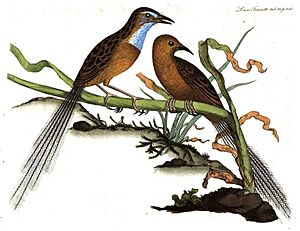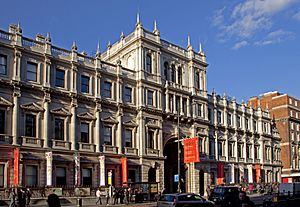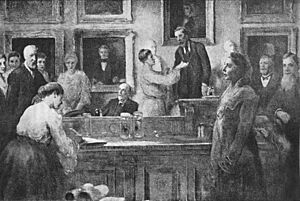Linnean Society of London facts for kids
 |
|
| Formation | 1788 (royal charter: 1802) |
|---|---|
| Type | Learned society |
| Purpose | Natural History, Evolution & Taxonomy |
| Location |
|
|
Membership
|
3,168 (as of 2023[update]) |
|
President
|
Mark Watson |
| Remarks | Motto: Naturae Discere Mores ("To Learn the Ways of Nature") |
The Linnean Society of London is a special group dedicated to studying and sharing information about the natural world. This includes natural history (the study of plants and animals), evolution (how living things change over time), and taxonomy (how we name and group living things).
The society has amazing collections of plants, animals, old letters, and books. They also publish academic journals and books about biology. Plus, they give out important awards and prizes.
Started way back in 1788, the Linnean Society is the oldest group of its kind in the world that is still active today. It's famous because it was where the idea of evolution by natural selection was first shared with the public on July 1, 1858.
The society has some very important people as patrons and honorary members. These include Anne, Princess Royal, King Charles III of the United Kingdom, Emeritus Emperor Akihito of Japan, King Carl XVI Gustaf of Sweden, and the famous naturalist Sir David Attenborough.
Contents
History of the Society
How the Society Started
The Linnean Society was created in 1788 by a botanist named Sir James Edward Smith. The society is named after Carl Linnaeus, a Swedish scientist often called the "father of taxonomy." He created a system for naming and classifying living things using two names, like Homo sapiens for humans. This system is called binomial nomenclature.
The society officially became "The Linnean Society of London" on March 26, 1802, when it received a royal charter. At that time, it had 228 members. It is the oldest natural history society in the world that is still going strong. The society has always focused on advancing natural history, staying out of politics and other debates.
Sir James Edward Smith started the society after he bought Carl Linnaeus's huge collection of specimens, books, and letters. Sir Joseph Banks, a famous botanist, encouraged Smith to buy the collection. Five years later, Banks fully supported Smith in starting the Linnean Society and became one of its first honorary members.
Famous Members of the Society
Many important scientists have been members of the Linnean Society. One was the botanist Robert Brown, who was a librarian and later president. He discovered the cell nucleus and something called Brownian motion.
In 1854, Charles Darwin became a member. He is one of the most famous scientists ever to be part of the society. Another well-known member was the biologist Thomas Huxley, who was nicknamed "Darwin's bulldog" because he strongly defended Darwin's ideas about evolution.
Other famous people from different fields have also been members. These include Edward Jenner, who created the first vaccination, and explorers like Sir John Franklin and Sir James Clark Ross. Even a former Prime Minister of the United Kingdom, Lord Aberdeen, was a member.
Evolution and the Society
The idea of "Evolution by Natural Selection," a huge step forward in biology, was first shared publicly at a Linnean Society meeting on July 1, 1858. At this meeting, papers by Charles Darwin and Alfred Russel Wallace were presented together. Neither author could be there, so Joseph Hooker and Charles Lyell presented their work for them.
The society's connection to evolution continued to be strong into the 20th century. Sir Edward Poulton, who was president from 1912 to 1916, was a big supporter of natural selection. He was also the first biologist to understand the importance of something called frequency-dependent selection.
Women Members
In 1904, the society welcomed its first women members, after years of hard work by the botanist Marian Farquharson. While some leaders of the society were unsure about letting women join, most members were supportive. Only 17% voted against the idea.
Some of the first women to join on January 19, 1905, included:
- Emma Louisa Turner, an ornithologist (bird expert) and photographer.
- Lilian J. Veley, a microbiologist.
- Annie Lorrain Smith, who studied lichen and fungi.
- Gulielma Lister, another mycologist (fungi expert).
- Margaret Jane Benson, who studied ancient plants.
Other women elected in 1904 included Marie Stopes, who studied ancient plants and later helped with family planning, and Constance Sladen, a kind person who started a trust. Alice Laura Embleton, a biologist and zoologist, was also among them. She had given a paper to the society as early as June 4, 1903. In total, 15 out of 16 women nominated in 1904 were elected. Marian Farquharson herself was not admitted at first, which the society now calls "shameful," but she finally joined in 1908.
A painting called "Admission of Lady Fellows" by James Sant shows eleven women signing the society's membership book on January 19, 1905. This painting hangs on the upper staircase of the society's building.
The first woman president of the society was Irene Manton (from 1973 to 1976). She was a pioneer in using electron microscopy in biology. Her work helped us understand the structure of flagellum and cilia, which are important for how cells move.
Current Interests
In recent years, the society has become more interested in protecting biodiversity, which means protecting the variety of life on Earth. To show this, they started an annual award in 2015, the John Spedan Lewis Medal. This award honors people who make important and new contributions to conservation.
Locations of the Society
The Linnean Society has had several homes over the years. It started in a coffee house in 1788, then moved to different streets in London. Since 1857, the society has been located at Burlington House in Piccadilly, London. It shares this address with other important societies, like the Geological Society of London and the Royal Astronomical Society.
In April 1939, because of the threat of World War II, the society had to move its collections out of London. They went to Woburn Abbey in Bedfordshire and stayed there for the entire war. The 12th Duke of Bedford, who was a member of the society, helped with this move. Three thousand of the most valuable books were sent to Oxford for safety. The society's records were kept safe at the country home of their librarian.
Becoming a Member
Anyone who loves natural history can become a member, whether they are professional scientists or amateur naturalists. Having published scientific work is helpful but not required to be elected.
Before November 2024, to become a member, you needed to be nominated by at least one current member. Then, at least two-thirds of the voting members had to approve you. After being elected, new members had to attend a meeting in person to formally join. This involved signing the membership book and agreeing to follow the society's rules. The president would then shake their hand and welcome them.
Since November 2024, a new "Fellowship Committee" reviews applications for membership. Current members can object if they have a good reason. To become a member, you need to apply with support from named references. The committee then tells the society's council if applicants are suitable. Once approved at a society meeting, applicants become members. Members can use the letters 'FLS' after their name.
There are other ways to be part of the society too. "Associate" members support the society without going through the full election process. "Student Associate" is for students. Associate members can apply to become full members at any time.
The society's Council can also invite people who strongly support the society's goals to become "Vice-Patrons." This role was created in November 2024. Before that, they were called "Honorary Members."
"Honorary Fellows" are limited to 75 people and are chosen by the society's Council. They are then elected by the other members. This role was created in May 2025. Before that, British subjects were called "Fellows honoris causa," and non-British subjects were called "Foreign Members."
Meetings and Events
Meetings have always been a main reason for the society to exist. They are places where people with similar interests can share information, talk about science, show off specimens, and listen to talks. Today, meetings are held in the evening and at lunchtime. Most are open to everyone, not just members.
Around May 24th, which is Carl Linnaeus's birthday, the Anniversary Meeting is held. This meeting is only for members and their guests. It includes voting for new council members and giving out medals. On May 22, 2020, for the first time ever, the Anniversary Meeting was held online using video calls. This was because of rules about public gatherings during the COVID-19 pandemic.
Awards and Prizes
The Linnean Society of London wants to encourage the study of all parts of biology. They especially focus on evolution, taxonomy, biodiversity, and sustainability. By giving out medals and grants, the society recognizes and supports excellent work in these areas.
Here are some of the medals and prizes given by the Linnean Society:
- Linnean Medal: Started in 1888, given every year to a botanist (plant expert) or a zoologist (animal expert), or sometimes to both.
- Darwin-Wallace Medal: First given in 1908, for big advancements in evolutionary biology.
- H. H. Bloomer Award: Started in 1963, for an amateur naturalist who has made an important contribution to biological knowledge.
- Trail-Crisp Award: Started in 1966, for outstanding work in biological microscopy published in the UK.
- Bicentenary Medal: Started in 1978, on the 200th anniversary of Linnaeus's death, for work done by a person under 40 years old.
- Jill Smythies Award: Started in 1986, for beautiful botanical illustrations.
- Linnean Gold Medal: Given in special cases since 1988 for great service to the society.
- Irene Manton Prize: Started in 1990, for the best botany dissertation (a long essay for a degree) in an academic year.
- Linnean Tercentenary Medal: Given in 2007 to celebrate the 300th birthday of Linnaeus.
- John C Marsden Medal: Started in 2012, for the best doctoral thesis (a big research project for a PhD) in biology in an academic year.
- John Spedan Lewis Medal: Started in 2015, for someone making a big and new contribution to conservation.
- Sir David Attenborough Award for Fieldwork: Started in 2015.
Collections of the Society


Carl Linnaeus's plant and animal collections were bought in 1783 by Sir James Edward Smith, the first president of the society. These collections are now kept by the society in London. They include:
- 14,000 plants
- 158 fish
- 1,564 shells
- 3,198 insects
- 1,600 books
- 3,000 letters and documents
You can see these collections by making an appointment, and there's a monthly tour available.
Sir James Edward Smith's own plant collection, which has 27,185 dried specimens, along with his letters and books, is also kept by the society.
Other important items held by the society include the notebooks and journals of Alfred Russel Wallace. They also have paintings of plants and animals made by Francis Buchanan-Hamilton (1762–1829) from Nepal.
In December 2014, the society's collections were given "designated status" by the Arts Council England. This means they are recognized as collections of national and international importance.
Images for kids
See also
 In Spanish: Sociedad Linneana de Londres para niños
In Spanish: Sociedad Linneana de Londres para niños






